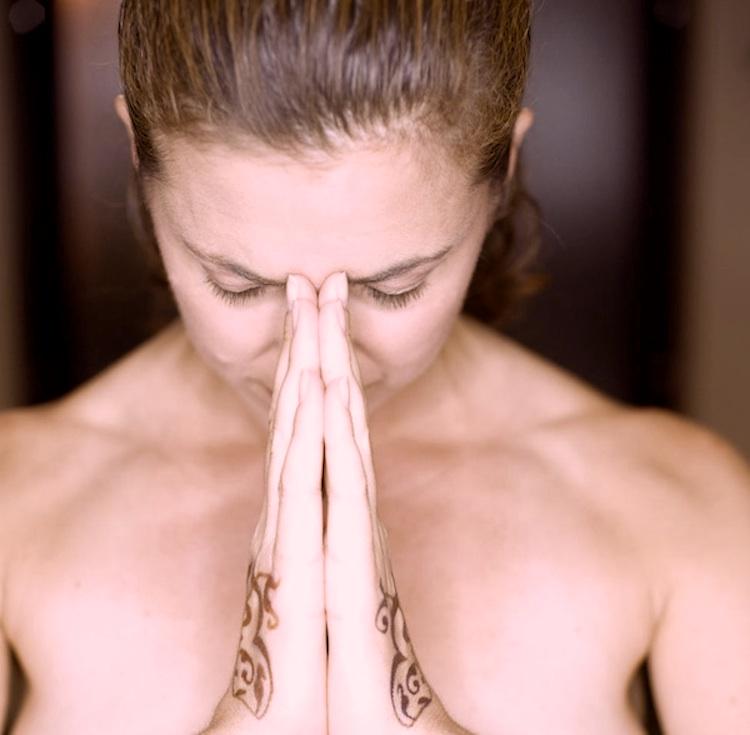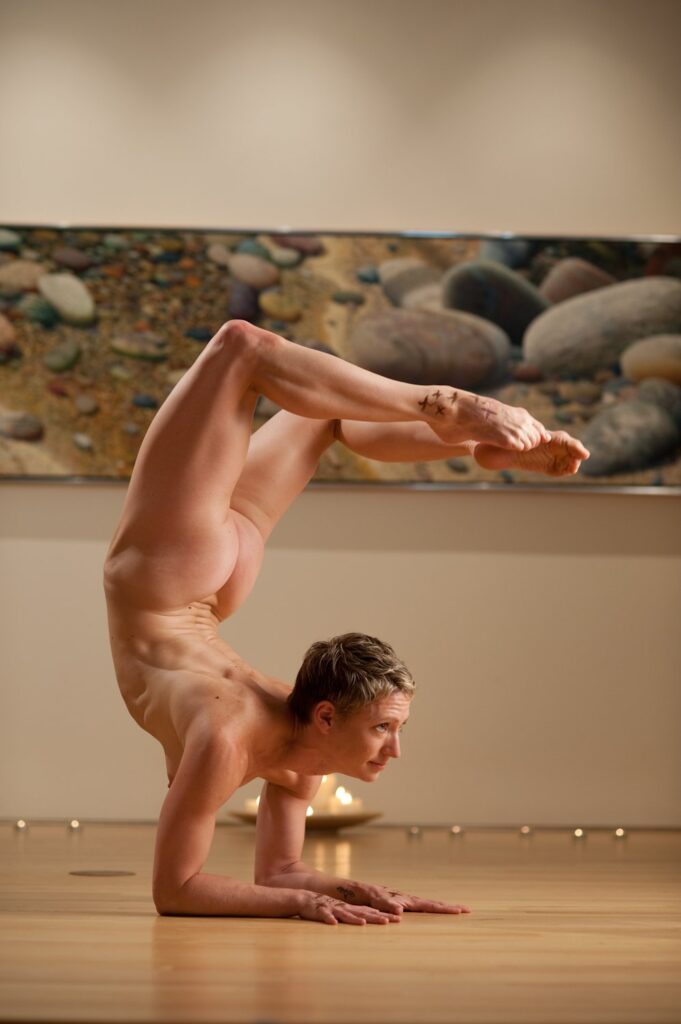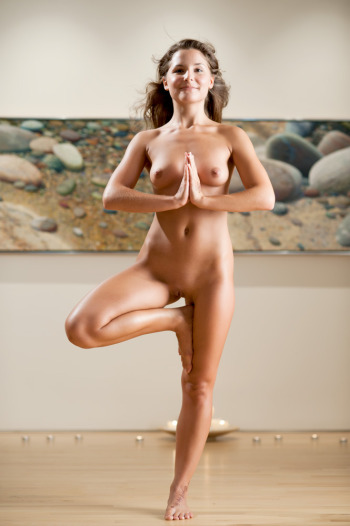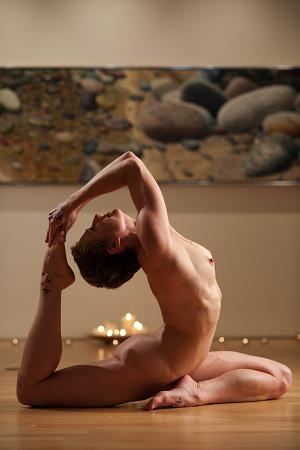

“The soul, like the moon
is new and always new again
and I have seen the ocean
continuously creating.
Since I washed my mind
and my body, I too,
am new, each moment new.
My teacher told me one thing:
Live in the soul.
When that was so,
I began to go naked and dance.”~Lalla
Naked Yoga
Yoga and meditation
Naked yoga, in it’s true form, has very little to do with sex and eroticism. Naked yoga originated with the Naga Sadhus, a sect of Yogis in India, dating back to the 8th Century BC. Their name describes the philosophy and thinking that is central to their approach to yoga and spirituality. The word Naga means “naked,” and the word Sadhu, “one who has renounced the world completely.” Nudity on the part of the Sadhus is a symbol of renunciation of all things material; symbolically, by renouncing their clothes, they renounce ambition and any attachment to objects, emotions or desires. There is a sect of the Sadhus that even renounces sex and embraces celibacy and learns to face the harsh elements without concern for physical comfort or satisfying human desires, including the freezing cold of the Himalayas, where many of them reside. These acts are meant to help break the attachment and identification they have with the physical body and sense organs, and allocate energy and attention towards utilizing the body as a means towards reaching enlightenment.

he real meaning behind nudity in the yoga practice, specifically, the Sacred Tantric Practice in Yoga Undressed, in its purest form, describes the resolution of conflicts between the opposites in life--finding the perfect balance between the deepest and most complete connection to the body, while simultaneously cultivating absolute detachment from it, in order to encounter the eternal soul essence, or the pure energy of creation. The purpose of yoga is to create a vibrant, powerful energetic connection to the body, but not as obvious is the goal of detachment from the body, the recognition of the body as a temporary dwelling place for the soul. A true naked yogi, then is one who has shed his coverings, not only his clothing, but his attachment to the myriad and insidious aspects of all human drama and resides in and embraces his pure, untouched, infinite nature.
Don’t be so quick to condemn my nakedness. A man is one who trembles in the Presence. There are very few of those. Why not go naked? The ram of experience must be fed And ripened for the sacrifice. Then all these customs will disappear like clothing. There’s only the soul. ~Lalla
Tantra

“Rend the veil, the coverings, both metaphorical and literal and truth, no longer obscured, reveals itself.” ~Lalla
Tantra and Kundalini
Kundalini is actually a form of Tantra, the divine feminine, the Goddess. The Kundalini exercises in The Goddess Series are intended to help you to recognize your true nature and surrender to your own divine essence.
Kundalini, or “coiled snake” in Sanskrit, is a psycho-spiritual energy of consciousness that exists within each one of us. It is the energy of existence. To awaken it is to manifest pure awareness, love and joy. This unrefined, creative energy lies tightly coiled at the base of the spine. In Yoga Undressed, we learn to unleash this “coiled snake” of energy, our Kundalini shakti, channeling it up through the spine, with the powerful, yet accessible warm up series we do at the beginning of each practice.
You will meet your Kundalini shakti, your sacred, sexual energy, your “secret tool,” through the postures and the breath, making you feel more alive, radiant and sensual. Kundalini has the power to transform, manifesting in great health, creativity, and abundance, inspiring you to reach your full potential in every area of your life. Kundalini awakening opens the door– you have only to walk through it.

Kundalini energy rises up a delicate channel of the spine called the Sushumna, the central channel that runs from the first chakra, the Muladhara, all the way up to the 7th, the Sahasrara. The essence of Tantra itself, it rises up the spine like two snakes intertwined and symbolize the union of the Ida, the feminine energy of the left channel, and Pingala, the masculine energy of the right channel. These are the two subtle pathways of energy that allow the awakened kundalini to ascend from the base of the spine to the crown of the head. One cannot exist without the other and balance cannot exist without both present in the subtle energy body. To achieve self-realization, a yogi must awaken his divine nature, which can only happen if everything in his yoga practice works in concert. Asanas (postures) and pranayama (breathing techniques) awaken the chakras. The chakras in turn activate the nadis, an action that causes the chakras to vibrate. The energy generated from the chakras then flows up through the nadis and circulates in the body. As each chakra uncoils, emotions rooted there arise and transform into divine energy.
Within the yogi’s body, Shakti is the Kundalini serpent, which lies asleep at the base of the spine, blocking the door to “final liberation,” or Samadhi. The goal of Tantra yoga is to forcibly awaken Shakti, controlling and directing the cosmic energy, the shakti-prana or life-force, so that she will rise up through the Sushumna channel to the Sahasrara chakra at the crown of the head and unite with Shiva– the divine masculine. This union represents the reunion of all opposites, the union of spirit and nature–the combination of physical sexuality with mental and spiritual transcendence. And it is this joining of sexuality with the spirit of the divine that ultimately, through practice, produces a state of transcendence and indescribable bliss.
In The Goddess Series, we invite you to celebrate sexuality as a spiritual exercise, a means of attaining oneness and aliveness in the body, mind and spirit– true union, both mystical and energizing.

Your body is a temple. Come inside and pay homage. Honor yourself with love and gratitude.
Feel the freedom of being naked, the natural grace and ease of being completely unfettered, unencumbered by clothing.
Surrender to your natural, authentic being.
Embrace the beauty and simplicity of who you really are.
Return to innocence, a sanctuary for your spirit where you can cultivate strength, grace, intimacy and reverence for your own sacred self.
Awaken your spirit, nourish your life force, and unleash the fullness of your potential!
In Celebration!
Namaste~


